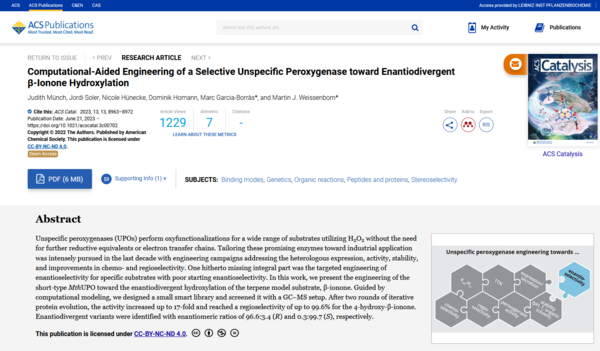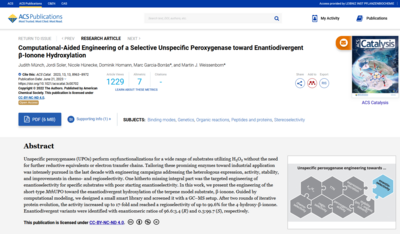First enantioselective UPO by enzyme engineering.
Nonspecific peroxygenases (UPOs) of fungal origin catalyze a wide range of hydroxylation reactions very efficiently and require only hydrogen peroxide as cosubstrate. However, their use as biocatalysts in selected synthetic and biotechnological processes is sometimes limited by their suboptimal regio- and enantioselectivities towards certain substrates. Over the past decade, these enzymes with promising potential for industrial applications have undergone intense engineering efforts, focusing on heterologous expression, activity, stability, and improvement of chemo- and regioselectivity. Still, the enantioselectivity for specific substrates in enzymes with poor initial enantioselectivity was yet to be tackled. Scientists at IPB and partners from MLU and Spain have now succeeded for the first time in enabling the enzyme MthUPO, derived from the thermophilic fungus Myceliophthora thermophila, for the enantioselective hydroxylation of the terpene model substrate β-ionone.
As a result of their computer-assisted enzyme engineering, they created two MthUPO variants, each of which was characterized by a high (R)- or (S)-enantioselectivity of nearly 100 percent. Both variants also showed high regioselectivities and a 17-fold increase in enzyme activity. Based on in silico predictions, the chemists were able to identify the relevant residues for substrate binding at the enzyme's active site and accordingly create a small library of 1600 enzyme variants, from which they fished those MthUPOs that preferentially convert either the (R)- or (S)-form of the β-ionone substrate. The screening of the enantioselective enzyme variants was performed by the so-called MISER method, a rapid GC-MS-based assay previously developed by the Halle scientists (See News Ticker #43).
Not least, the team’s efforts turned out succesful because the active site of MthUPO is particularly well suited for selectivity development approaches due to its hydrophobic properties. This significantly reduced the amino acid alphabet for the redesign of the active site to only hydrophobic amino acids. The present work paves the way for the rapid engineering of UPOs for the enantioselective conversion of terpene derivatives and other substrates, thus solving one of the last remaining challenges in UPO research, the scientists conclude.
This is especially true for the development of future biocatalysts to produce specific terpenes, which are compounds of interest for medical applications due to their excellent pharmacological activities. Ionones known as rose ketones, which were used as terpenoids for this experiment, are also highly valued substances in the fragrance industry. The annual production of β-ionones is 4000-8000 tons worldwide. In addition, these fragrances act as important building blocks for the synthesis of many carotenoids and retinol (vitamin A). Numerous pharmacological activities have been described for their derivatives, including both anti-cancer and cancer-promoting, as well as anti-inflammatory and antimicrobial effects.



